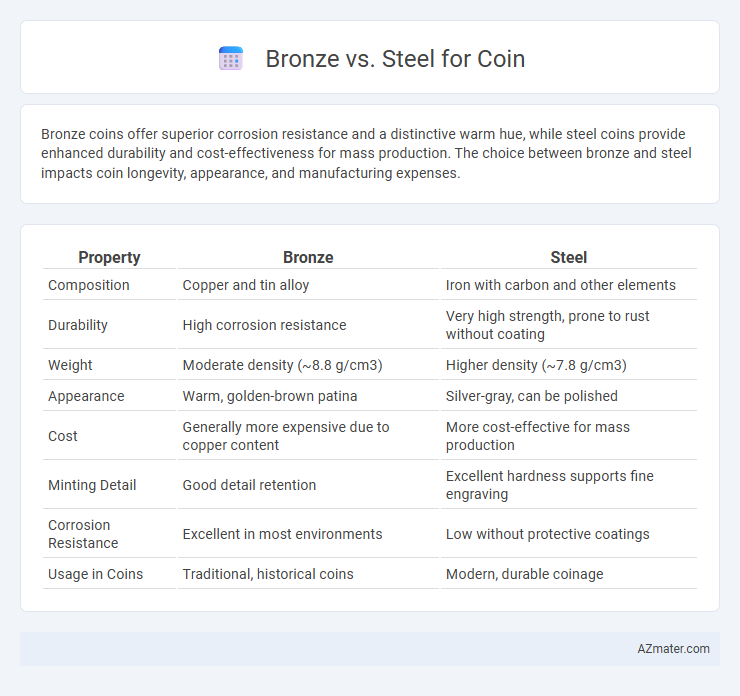Bronze coins offer superior corrosion resistance and a distinctive warm hue, while steel coins provide enhanced durability and cost-effectiveness for mass production. The choice between bronze and steel impacts coin longevity, appearance, and manufacturing expenses.
Table of Comparison
| Property | Bronze | Steel |
|---|---|---|
| Composition | Copper and tin alloy | Iron with carbon and other elements |
| Durability | High corrosion resistance | Very high strength, prone to rust without coating |
| Weight | Moderate density (~8.8 g/cm3) | Higher density (~7.8 g/cm3) |
| Appearance | Warm, golden-brown patina | Silver-gray, can be polished |
| Cost | Generally more expensive due to copper content | More cost-effective for mass production |
| Minting Detail | Good detail retention | Excellent hardness supports fine engraving |
| Corrosion Resistance | Excellent in most environments | Low without protective coatings |
| Usage in Coins | Traditional, historical coins | Modern, durable coinage |
Introduction to Coinage Materials
Bronze and steel are prominent materials used in coinage, each offering distinct advantages in durability and corrosion resistance. Bronze, an alloy primarily of copper and tin, has historically been favored for its workability and aesthetic appeal, making it ideal for intricate designs. Steel, often coated with a thin layer of zinc or nickel, provides enhanced strength and cost-effectiveness, especially in modern mass coin production.
Historical Overview: Bronze and Steel Coins
Bronze coins have been used since ancient civilizations such as Mesopotamia and Rome, prized for their durability and affordability compared to precious metals. Steel coins emerged in the 20th century, especially during wartime periods like World War II, when copper and nickel became scarce. The transition from bronze to steel often reflected economic pressures and advancements in metallurgy, with steel offering a harder but more corrosion-prone alternative.
Composition and Properties of Bronze Coins
Bronze coins are primarily composed of copper and tin, typically featuring about 88% copper and 12% tin, which gives them excellent corrosion resistance and durability. The alloy's hardness makes bronze coins wear-resistant, ensuring longer circulation life compared to softer metals. Its reddish-brown color and antibacterial properties also contribute to its historical preference for coinage.
Composition and Properties of Steel Coins
Steel coins primarily consist of low-carbon steel, often coated with zinc or nickel to enhance corrosion resistance and durability. Compared to bronze, steel exhibits higher tensile strength and magnetic properties, contributing to improved wear resistance in circulation. The alloy composition and protective plating result in coins that maintain their appearance longer and withstand harsher environmental conditions.
Durability and Wear Resistance Comparison
Steel coins exhibit superior durability compared to bronze due to steel's higher tensile strength and resistance to deformation under stress. Bronze, an alloy primarily of copper and tin, offers good corrosion resistance but wears down faster than steel when subjected to frequent handling and friction. The enhanced hardness of steel ensures that coins maintain their design features longer, making steel the preferred choice for high-circulation currency with enhanced wear resistance.
Corrosion and Environmental Impact
Bronze, an alloy primarily composed of copper and tin, exhibits superior corrosion resistance compared to steel, making it less prone to rust in humid or acidic environments. Steel, especially carbon steel, is more susceptible to oxidation and rust, requiring protective coatings to enhance durability and longevity in coin production. From an environmental perspective, bronze's copper content involves higher mining-related ecological impacts, while steel's recyclability and lower mining footprint present more sustainable options for large-scale coin manufacture.
Cost and Economic Considerations
Bronze coins generally have lower production costs than steel due to the higher expense of raw materials like copper and tin, yet steel's lower unit cost makes it more economical for high-volume minting. Bronze offers better corrosion resistance, reducing long-term maintenance expenses, whereas steel may require protective coatings to avoid rust, impacting overall costs. The choice between bronze and steel hinges on balancing initial material expenditures with durability and lifecycle costs in coin manufacturing.
Aesthetic Differences: Color and Finish
Bronze coins exhibit a warm, rich reddish-brown tone that develops a natural patina over time, enhancing their antique appeal and depth of color. Steel coins typically feature a cooler, silver-gray hue with a smooth, reflective finish that maintains brightness longer but may be prone to corrosion without proper plating. The contrasting colors and finishes between bronze and steel significantly influence the visual and tactile experience, with bronze offering a classic, vintage look and steel presenting a modern, sleek aesthetic.
Use Cases: When Nations Choose Bronze or Steel
Nations often select bronze for coins due to its durability and resistance to corrosion, making it ideal for lower denomination coins that require frequent handling. Steel, which is more cost-effective and magnetic, is preferred for mass production of coins during periods of economic strain or when rapid minting is necessary. The choice between bronze and steel hinges on factors such as budget constraints, coin circulation volume, and desired lifespan of the currency in circulation.
Conclusion: Which Metal is Best for Coins?
Bronze offers superior corrosion resistance and a classic, historic appeal, making it ideal for collectible or commemorative coins; steel excels in durability and cost-effectiveness, suited for everyday circulation coins requiring high wear resistance. The choice depends on the coin's intended use--bronze for aesthetic and longevity, steel for mass production and resilience. For long-term value and artistic detail, bronze is preferred, while steel serves best in high-volume, practical currency applications.

Infographic: Bronze vs Steel for Coin
 azmater.com
azmater.com